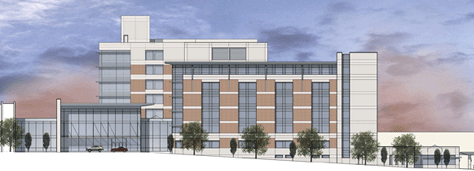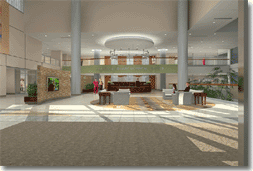

Nicole R. Lucas
Structural Option
Franklin Square Hospital
Patient Tower Addition
Baltimore, MD
| HOME |
| STUDENT BIO |
| BUILDING STATISTICS |
| THESIS ABSTRACT |
| TECHNICAL ASSIGNMENTS |
| THESIS RESEARCH |
| THESIS PROPOSAL |
| PRESENTATION |
| FINAL REPORT |
| REFLECTION |
| E-STUDIO HOMEPAGE |
“Note: While great efforts have been taken to provide accurate and complete information on the pages of CPEP, please be aware that the information contained herewith is considered a work‐in‐progress for this thesis project. Modifications and changes related to the original building designs and construction methodologies for this senior thesis project are solely the interpretation of Nicole Lucas. Changes and discrepancies in no way imply that the original design contained errors or was flawed. Differing assumptions, code references, requirements, and methodologies have been incorporated into this thesis project; therefore, investigation results may vary from the original design.”
Updated Proposal (1/15/09)
Full Proposal
Executive Summary and Breadth Studies
The proposed solution is to change the current concrete flat-plate structural system to a steel composite system. The current concrete moment frame lateral resisting system will be replaced with seismically designed steel moment frames. All layout options will be explored and the best configuration for the building plan will be determined. Vibration criteria will be met according to AISC Design Guide 11. Research will need to be done on seismically detailed moment frames and a preliminary comparison between seismically designed moment frames and non-seismically designed moment frames will be completed. A basic gravity load analysis will be done to determine preliminary member sizes including vibration design.
Lateral loading will be determined and analyzed including an intensive study of the transfer of the loads. A 3-D computer model will be created and used to analyze a new steel structural system. Serviceability checks will be done including drift and overturning moments. Foundation investigation will be done to consider a new foundation design for the lighter design. New drawings will be included for the steel structural system.
M.A.E. Components
Seismically designed steel moment connections will be designed; using knowledge obtained from AE 534, and placed in the most efficient, economical configuration after all configurations are explored for the Patient Tower Addition. Also, a 3-D model will be created utilizing the education from AE 597A.
Breadth Topics
- Architectural
Changing the patient tower’s structural system to steel will result in an impact on the architecture of the building. From a preliminary study done in technical report 2, it was found that the floor-to-floor height will increase approximately 16”. There was not an issue with height restrictions for the patient tower so this increase will not cause trouble with zoning. The façade will need to change with the increase of approximately 9 feet. Since the patient tower is an addition, the integration of the façade needs to be considered. Sketches of the new façade will be completed, keeping in mind the integration and the comfort of the patients.
Not only will the façade of the building be changed, but the floor plan will have some changes due to the steel system. The current 22”x22” concrete columns will be redesigned using steel W-shapes. Most likely the columns will be able to be incorporated into the walls providing some extra space. Investigations will be conducted to see if this space will increase some of the areas. The free space and the more open floor plan will lend some alternatives to the plan. While the floor plan will provide more flexibility, the design of the architect and the needs of the hospital must be accounted for. Drastic changes will be avoided unless necessary.
- Construction Management
An exploration of the impact on the schedule and cost of the steel structure will be done to check constructability and feasibility of the new design. A new schedule will be completed to account for the steel construction. Steel fabricators in the area will be researched and incorporated in the schedule including lead time and fabrication.
All available information will be obtained concerning the current schedule and cost. This information will be used to construct a mock schedule. Remaining information that cannot be obtained from the construction management company will be checked with RS Means.
An overall comparison between the concrete and steel systems will assist in determining the advantages and disadvantages of each system. These will be analyzed and a conclusion will be drawn if one system is considerably a better option than the other design.
|
||
The Capstone Project Electronic Portfolio (CPEP) is a web‐based project and information center. It contains material produced for a year‐long Senior Thesis class. Its purpose, in addition to providing central storage of individual assignments, is to foster communication and collaboration between student, faculty consultant, course instructors, and industry consultants. This website is dedicated to the research and analysis conducted via guidelines provided by the Department of Architectural Engineering. For an explanation of this capstone design course and its requirements click here.
